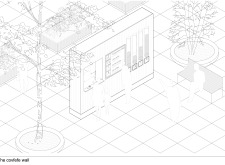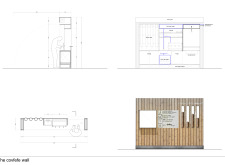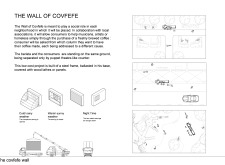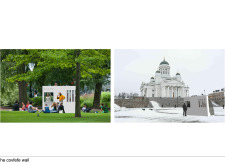5 key facts about this project
The overall concept draws inspiration from the surrounding landscape and urban fabric, seamlessly integrating the structure into its environment. The design employs a thoughtful arrangement of volumes that guide movement and flow within and around the building. This intentional choreography of spaces reflects a deep understanding of human experience and connection to place, fostering a sense of belonging among its users.
Materiality plays a crucial role in reinforcing the design's intent. A palette of locally sourced materials is utilized to minimize the project's carbon footprint, embody a sense of place, and celebrate regional craftsmanship. The exterior façade consists of sustainably harvested wood and textured metal, presenting a warm yet modern aesthetic. Large windows punctuate the structure, inviting natural light to permeate the interior spaces while offering views of the surrounding landscape. This interplay of light and shadow adds a dynamic quality to the architecture, changing throughout the day and enhancing the user experience.
Key design elements include flexible interior layouts that can be adapted for various functions. This adaptability is achieved through the incorporation of movable partitions, which allow spaces to be reconfigured for community events, workshops, or smaller gatherings. The integration of green spaces is another hallmark of the project; strategically placed gardens and terraces not only enhance biodiversity but also provide vital outdoor areas that encourage social interaction and well-being among users.
The architectural approach emphasizes a sustainable design philosophy, where energy efficiency is prioritized through features such as rainwater harvesting systems, solar panels, and high-performance insulation. These design elements not only align with contemporary sustainability standards but also serve as educational tools, inspiring users to engage with environmental consciousness.
Unique design approaches are evident in the building's layout and façade treatment. The incorporation of green roofs and vertical gardens introduces an organic element to the urban environment, while also addressing heat island effects and promoting biodiversity. The building's orientation is meticulously considered to maximize energy efficiency, allowing passive solar gain in winter and minimizing heat absorption in summer.
In addition to these aspects, the project includes communal areas such as lounges, study rooms, and performance spaces, fostering an environment where creativity and collaboration thrive. The architecture is designed to be accessible, with inclusive features that ensure it welcomes individuals from all walks of life. Throughout the design process, the architects prioritized the user's experience, resulting in a building that is not merely a physical structure but a vital part of the community fabric.
To further explore this project, readers are encouraged to look into the architectural plans, architectural sections, and architectural designs that detail the thought processes and ideas underlying this compelling architectural work. Engaging with these resources will provide a deeper understanding of the design's impact and the innovative ideas that drive it forward.


























